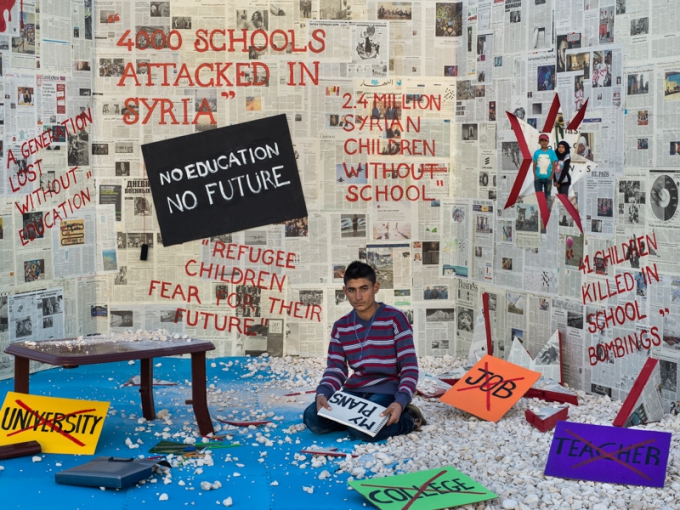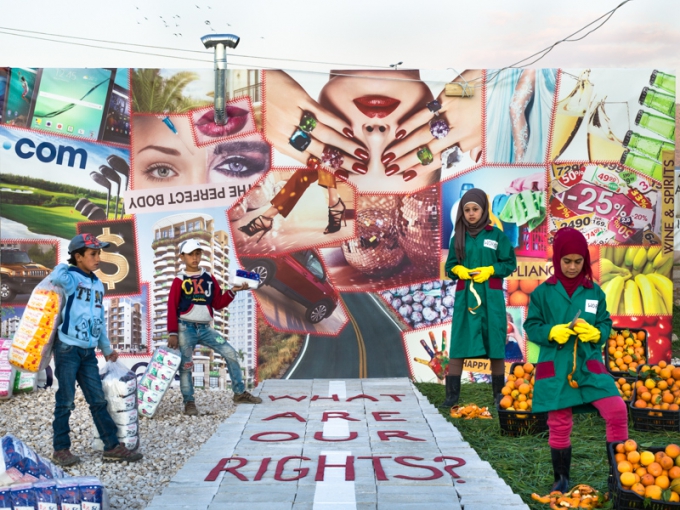Photography Project Delves into the Dreams of Children

A school shelled, a house destroyed and a dream shattered. A childhood thrown into the anarchy of conflict and the future of a whole generation is taking a dangerous, unforeseeable twist.
This is the story that award-winning French photographer Patrick Willocq tells in a series of four shots. Commissioned by Save the Children, the Photography Project in the Bekaa Valley combines art and human elements to produce a visual display that hardly needs words to explain.
The collection takes us through the children’s past and present, foretelling uncertain future in a time of conflict and displacement. The tale is narrated by the children themselves, translating their ideas and emotions into a staged set of colourful snaps that feel as though they have been just extracted from their sad memories, thoughtful dreams or harsh realities.
The artworks were completed over three weeks, during which refugee children and their families were approached in Bekaa’s informal settlements to speak of their perilous journey from war-torn Syria to seek safety in neighbouring Lebanon. Though united by destiny, each child has a unique story that they wanted to share.
‘’We have been on the ground for eighteen days,’’ said Willocq.
‘’we’ve been working with the kids and it was great. We have also worked with local artists [to build the stage], so it took a lot of groundwork. I’m pleased with the result.’’
The Past

Willocq’s first shot takes us back to the moment Jana*, 11, saw her school in Syria get bombed, an image that sticks in her memory. A joyful day was blanketed in bellowing smoke and deafened by the rattling noise of explosions. In split of a second, a shocking thought flashed across her mind.
‘’I saw the plane shelling my school,’’ recalled Jana. ‘’I immediately thought I wouldn’t be able to become a doctor anymore. I couldn’t go to any other school because it was the only school in our village.’’
Jana was willing to re-enact that moment from the past- transferred into a 3D artwork- because it brought back the time when she used to be with her friends, playing and going to school.
Education

Kneeling on the floor amid the rubble, Hatem* eyes his grim reality with a dejected stare in the ‘Education’. The aftermath of destruction in his town in Syria has forced children out of school and families away from home.
‘’The hole in the picture refers to the one left by the rocket that hit my school,’’ said 15-year-old Hatem. ‘’Children like me aren’t able to go to school anymore. I wish we can have the chance to study again.’’
The enormous impact of the Syria Crisis on millions of lives leaves the whole future of a generation in complete disarray. Inside the country and outside, there are 2.4 million children who are out of school. The numbers and figures that flood the front pages worldwide are summed up in two noes on a large plank of wood: ‘No Education, No Future’.
Child Labour

‘Child Labour,’ as the name suggests, tackles one of the biggest challenges that face vulnerable children in refuge.
As revealed by Save the Children in the ‘Small Hands, Heavy Burden report,’ children as young as six are working for as little $4 a day. The different forms of child labour include harvesting potatoes and selling tissues, and could amount to hazardous labour and illicit work.
Bassam*, Tamer*, Lubna* and Farah* are four victims of child labour. Hardship and poverty forced them to suspend their education and work to earn daily bread for their families.
Bassem and Tamer sell tissues on the street that only secures fractions of income. Their father sustained injuries to his leg during shelling in Syria, which restricted his movement and stopped him from work.
The two brothers re-enact their mornings by posing on a bespoke stage that resembles a street. The message, they hope, will be heeded by a world in which millions of children are being forced to work prematurely.
‘’It tells the world about the suffering of refugees and children,’’ explained Bassam, 12.
‘’We hope people see the picture and help us stop selling tissues and go to school again. All children should be in school.’’
On the other flank, the snap captures a rare standing posture of the two working girls. Lubna and Farah spend the largest chunk of their day bending down as they collect potatoes and cut bad roots. In the picture, they are seen peeling orange in their industrial attire.
‘’This picture speaks out about our right as children,’’ said Farah.
‘’Children of my age shouldn’t be working. I am supposed to be going to school but I need to support my family.
‘’I go out to the field to remove bad parsley and lettuce. I get tired because I work for long hours, I bow for long time and carry heavy things, so my back hurts.’’
The Dream

In the last picture, 'The Dream', Zeina* and Samira* play the role of artist and princess respectively. Their dreams of being a painter and an actress was realised in a special set created to reflect their imagination.
‘’I love drawing and painting and always practice at home,’’ said Zeina. ‘’I draw my school and my family.’’
‘’I drew my friend Ghousoun sitting on a chair like a princess with flowers all around her. I also drew her palace. Patrick liked my idea and they copied the same drawing on a huge canvas. We painted and decorated together.’’
Samira, selected from among several talented children, wears a beaming smile as she sits on her majestic chair, surrounded by the magnificence of royalty life in its full glory. Scarlet curtains, a fireplace and precious furniture and metal items conjure up the unmistakable image of life that flirts with Samira’s mind.
‘’I want to be an actress because I like acting,’’ enthused Samira.
‘’I want to help my parents generate money. I always do acting when I am by myself and with my friends.
‘’I was so happy [to take part] because it was always my wish to play the princess.’’
Save the Children’s Photography Project is a wake-up call that invites the world to look into the suffering of a category neglected in their refuge. A look that goes beneath the surface to bring out a hidden element in the life of those displaced children- their dreams and future.
*All names have been changed for protection purposes.
 Lebanon
Lebanon